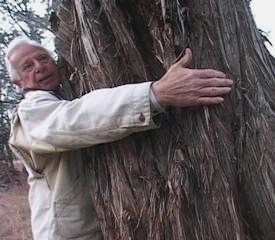Author: Bill Ward
For years I’ve heard many people say, “David Bamberger cleared the cedar off his land, and his springs started flowing.” Keep in mind I don’t mean David Bamberger said that; it’s what other people keep saying. If all he did was clear the mountain cedar (Ashe juniper), the Bamberger Ranch in Blanco County would not be that award-winning showcase for ecology-friendly land management famous around the world.
Judicious cedar clearing is just a part of Bamberger’s land management. He also works hard to restore grasslands and change slope drainage to increase infiltration and decrease runoff, thereby enhancing the local recharge of groundwater. To see what David Bamberger really says about cedar and water availability, check out the interesting April 25, 2010 issue of Bamberger Ranch Journal (http://brp-journal.blogspot.com).

For many people, the implication in “clear the cedar and start the springs” is that cedars are sucking up water that would otherwise filter down to recharge the aquifer and increase spring flow. Why don’t other common trees have the same effect as cedar? It always has puzzled me that the small needles of a seemingly xeric plant like Ashe juniper are transpiring more water into the atmosphere than are the broader leaves of larger trees. Apparently, that is a much too simplistic way to consider the matter.
According to research done by Keith Owens (A&M Experimental Station at Uvalde), there are two different issues to be considered with Ashe juniper: (1) loss of water by interception and evaporation and (2) loss of water by transpiration.
The scale-like juniper needles presumably capture rainfall and hold moisture in the needles. Supposedly juniper canopies can intercept 45% percent of rainfall, most of which can be lost through evaporation. Because so much of the Edwards Plateau is covered by Ashe juniper, this has important implications for hydrologists trying to estimate recharge based on rainfall. A smaller amount of water falling on junipers is funneled by stem flow to the root system. The contribution of the stem-flow water to groundwater recharge was not determined.
Dr. Owens, now at Oklahoma State, joined Dr. J.L. Heilman of Texas A&M and others in research focused on how water availability and aquifer recharge are affected by live oak and Ashe juniper encroachment into Edwards Plateau grasslands and savannas. This study that was published last year in the Journal of Hydrology.
The research was conducted on the Freedman Ranch near San Marcos during 2005 and 2006. Their conclusion was that the oak-juniper woodland relied heavily on water from recent rains, rather than water from deeper zones of root penetration. This casts doubt on the assumption “that woody species on the Plateau withdraw substantial amounts of water stored deep within the fractured bedrock which otherwise would find its way into the aquifer.” They also found live oak used more water than juniper in that study area. Dr. Heilman has been quoted as saying the idea of brush removal to save water is a case of where policy gets ahead of science.
The year before that report by Heilman and his associates, C.A. Jones and L. Gregory published a Texas Water Resources Technical Report in which they considered the effects of brush management on water resources. One of their conclusions is that removal of brush such as juniper and live oak from upland areas some distance from streams may increase stream flow and/or recharge aquifers, especially where the brush is dense and reduces the amount of rainfall reaching the soil surface and where seeps and springs feed the area streams. However, where soils and rocks “are not conducive to increased runoff and/or subsurface flows to streams or to aquifers,” brush control is unlikely to significantly increase water yields.
Is the jury still out? It sounds to me as if one model is not going to fit all areas of the Hill Country. A lot depends on the local geology. Of course, more work needs to be done, but at least scientific studies are being conducted. One day we’ll know the truth about Ashe juniper’s thirst.


